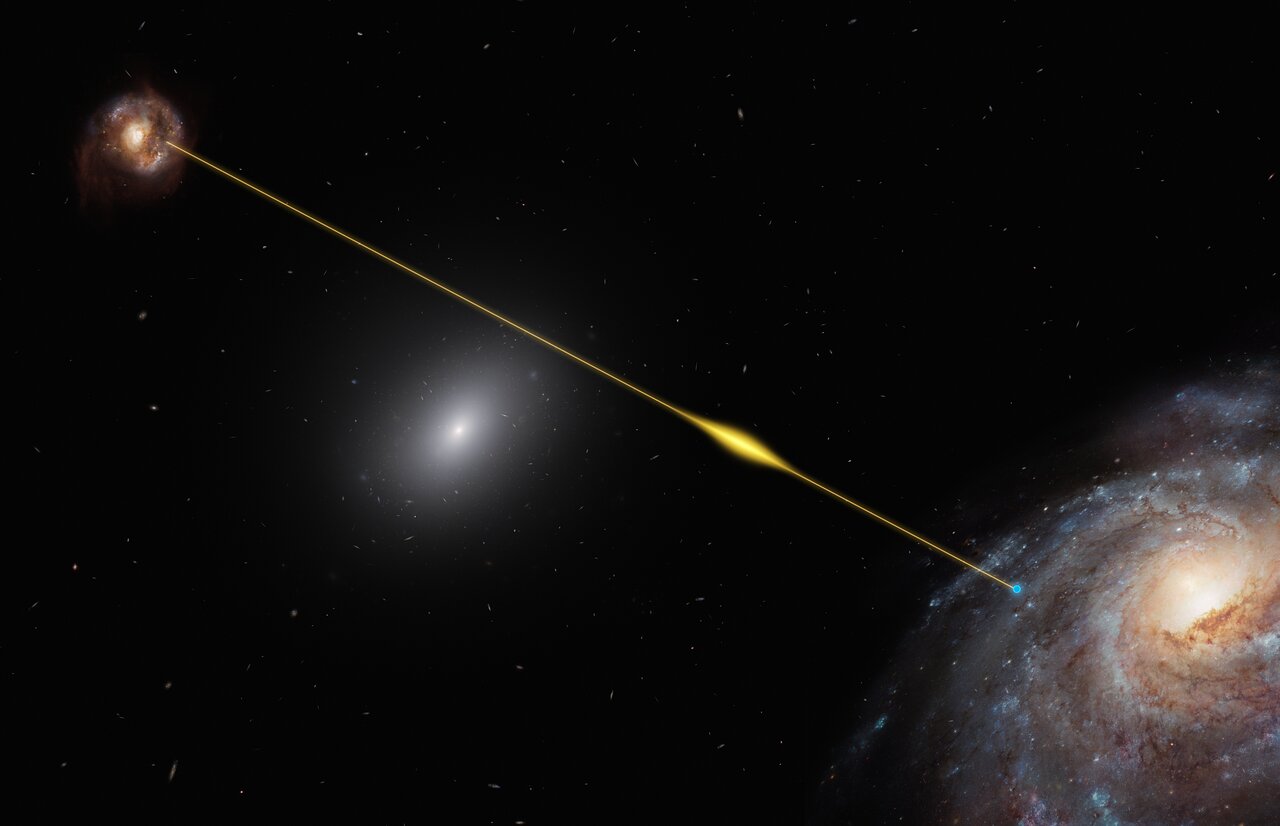 Earth & Space
Earth & Space
A peculiar bright burst of radio waves in the Milky Way
Peculiar, luminous radiation called ‘fast radio burst’ is a spectacular event with mysterious origins. In a new study, researchers observed the first fast radio burst in our own Milky Way. This discovery proves that a star, called a magnetar, is indeed the source of this intense radio beam and challenges current theoretical models.

What's out there? It's a fundamental but fascinating question in space science. Back in 1969, we managed to first travel to our neighbour, the Moon, and explore it. However, the whole picture is much more complex as most objects in the Universe are too far away to be reached with current technologies. To remotely access these 'unreachable' objects, scientists often rely on electromagnetic radiation emitted from them: the waves of the electromagnetic field such as radio waves, microwaves, infrared, visible light, ultraviolet, X-rays, and gamma rays. Measuring unique radiation patterns allow scientists to identify such remote objects. In a new study, researchers detected a unique event of radio wave emission named 'fast radio burst' firstly in our Milky Way associated with a magnetar, a special kind of neutron star.
A neutron star is made up of closely packed neutrons. It is famous as one of the densest objects in the Universe – a sugar cube of a neutron star appears to weigh about 1 trillion kilograms. A magnetar is a particular type of neutron star, whose name is given based on its exceptionally strong magnetic field. While the magnetic field of a typical neutron star is already trillions of times stronger than the Earth's, that of a magnetar is another 1000 times stronger. Magnetars are therefore the most magnetic known objects. They likely rotate very fast, even 1000 times per second, to achieve such strong magnetic fields.
The decay of the magnetar's magnetic field releases intense electromagnetic radiation, particularly X-rays and gamma-rays. Scientists measure these X-ray and gamma-ray patterns to distinguish magnetars. Moreover, magnetars are candidates for the source of very brief, bright emissions of radio waves. This event, named 'fast radio burst', lasts very short at the millisecond scale. Fast radio bursts release the energy equivalent of what our Sun emits during 10,000 years. Scientists have been long seeking the origins and the mechanisms of this spectacular event.
In April 2020, the researchers managed to detect a powerful fast radio burst accompanied by a burst of X-rays emitted from a magnetar, using multiple space- and ground-based telescopes. This magnetar, namely SGR 1935+2154, is located about 30,000 light-years away from the Earth in our own Milky Way. Intriguingly, this was the first fast radio burst observed in our Milky Way. Moreover, this fast radio burst has been the brightest radio burst ever detected in the galaxy.
This discovery proves that magnetars can indeed drive fast radio bursts. Comparing their observations with previous extragalactic observations, the researchers confirmed that the fast radio burst in the Milky Way was comparable with extragalactic fast radio bursts. However, it is puzzling why any fast radio burst had not been previously observed from any of the 30 known Milky Way magnetars. Observations of such exceptionally bright radio bursts might have been often misclassified and not been analyzed appropriately.
This observation provides insight into the mechanisms that undergo the emission of fast radio bursts. The observed temporal coincidence of the fast radio burst with an X-ray burst is consistent with a model known as plasmoid. In this scenario, a fast radio burst emission is generated by the ejection of the magnetar's magnetosphere – which is the space surrounding the magnetar dominated by the star's magnetic field. In this model, individual X-ray bursts from magnetars would result in radio emission being beamed in random directions, forming a fast radio burst.
In summary, researchers detected the first fast radio burst in our Milky Way. This discovery suggests that magnetars can produce fast radio bursts, shedding light on their mysterious origin. This is just the beginning and the future of fast radio burst astronomy should hold more surprises.
Original Article:
Bochenek, C. D. et al. A fast radio burst associated with a Galactic magnetar. Nature 587, 59-62 (2020).
Next read: Testing gravity through the distortion of time by Sveva Castello
Edited by:
Dr. Akira Ohkubo , Associate Editor
We thought you might like
A natural close-up of a pierced galaxy 18 billion light-years away
Oct 1, 2020 in Earth & Space | 3.5 min read by T. Emil Rivera-ThorsenA missing ingredient in dark matter theories?
Mar 31, 2021 in Earth & Space | 3.5 min read by Massimo MeneghettiWatching the death of a distant galaxy
May 4, 2022 in Earth & Space | 4 min read by Annagrazia PuglisiGas in distant galaxies: mixed or matched?
Nov 22, 2023 in Earth & Space | 3 min read by Tanita Ramburuth-HurtMore from Earth & Space
Discovery of the first radiation belt beyond the Solar System
Jan 27, 2025 in Earth & Space | 3.5 min read by Juan Bautista Climent OliverOne million (paper) satellites
Jan 24, 2025 in Earth & Space | 3 min read by Ewan Wright , Andrew FalleVolcanic Ash: A Nutrient Boost for Reef-Building Corals
Sep 18, 2024 in Earth & Space | 4 min read by Frank Förster , Tom SheldrakeAmmonia Energy: A Call for Environmental Awareness
Aug 29, 2024 in Earth & Space | 3.5 min read by Matteo Bertagni , Robert Socolow , Amilcare PorporatoLikely increase in coral thermal tolerance at a Pacific archipelago
Dec 29, 2023 in Earth & Space | 3 min read by Liam LachsEditor's picks
Trending now
Popular topics


